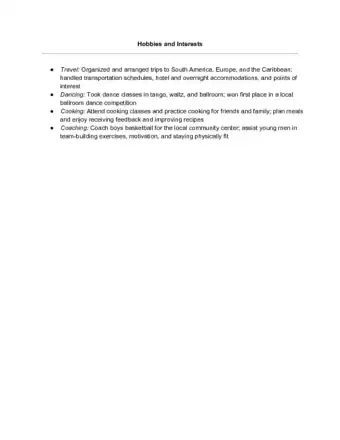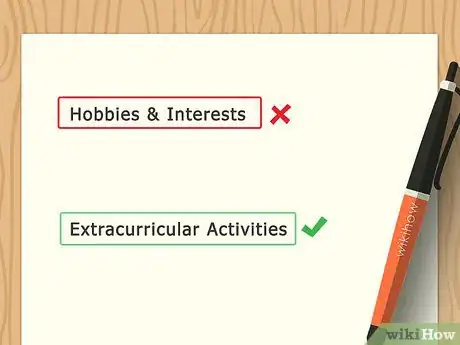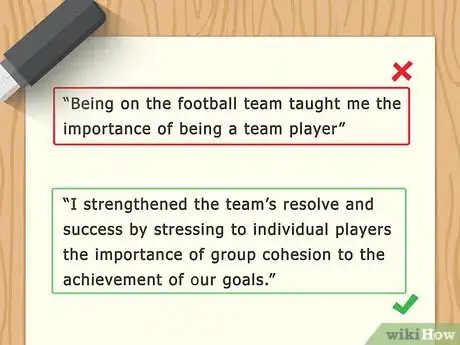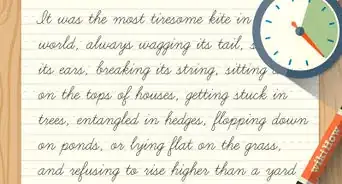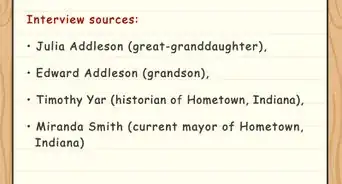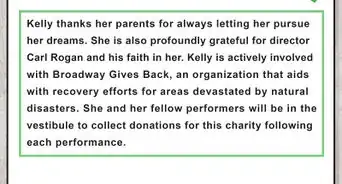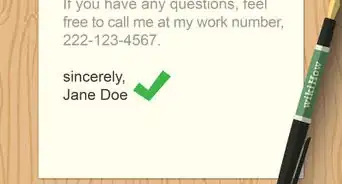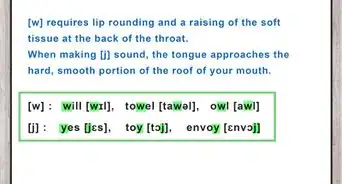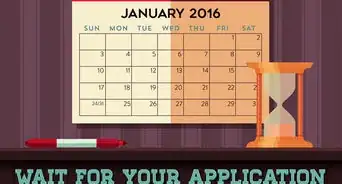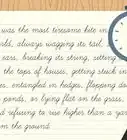This article was co-authored by Christopher Taylor, PhD. Christopher Taylor is an Adjunct Assistant Professor of English at Austin Community College in Texas. He received his PhD in English Literature and Medieval Studies from the University of Texas at Austin in 2014.
There are 7 references cited in this article, which can be found at the bottom of the page.
This article has been viewed 968,019 times.
The interests and hobbies section of a resume or college application provides a good opportunity to showcase your personality. A well-executed one can even compensate for a lack in experience or education. Although you might think that all resumes are alike, you should always gear your document toward the specific audience who will be reading it, taking into consideration what they want from you as an applicant. This article will discuss how to write about your hobbies and interests for the two audiences for a resume: a college admissions committee and a potential employer.
Steps
Writing Help
Writing for a College Admissions Committee
-
1Format your application resume by priority. You likely know the basic content of a resume — education, work experience, skills, awards, and hobbies. However, listing all that information is not enough. You must put thought into the order in which that information is presented on the resume.[1]
- College admissions committees are far more interested in your grades, work experience, skills and awards than they are in your hobbies and interests.
- As such, the hobbies and interests section of your resume should be presented toward the end of your resume. End with it, don’t lead with it.
- Prioritize individual activities as well. You can either list your activities chronologically, as you probably did in the “Work Experience” section, or from most to least impressive.
- Always remember that resumes are “top-down” documents, meaning you should lead with what you most want the reader to know about you.[2]
-
2Use appropriate terminology. Although you may think of tennis or chess as a fun hobby, the language you use in your resume should indicate more gravity. Rather than titling your “hobbies and interests” section “Hobbies,” call it “Activities” or “Extracurricular Activities.” By using more formal diction, you subtly give the impression that you exercised dedication and professionalism in practicing these activities, rather than simply goofing around and having a good time. This is what colleges are looking for.Advertisement
-
3Choose a formatting style for your listed sections. All of the sections of your resume that include detailed lists should be formatted in the same way. The “Activities” section of your resume should be formatted the same way as the “Work Experience” section. There is no single correct method to use, but you want to make sure that you give yourself room to not simply list your activities, but expand on them in a concise manner.[3]
- Do not simply list all of your activities with commas. This suggests that you have nothing to say about what you did other than the fact that you did it. Break each activity into its own bullet point.
- Decide whether you will write in full sentences or short phrases. A resume should not be overly long — ideally, it should fit onto a single page. If you find that your resume has too much length, use phrases rather than full sentences.
- For example: “Tennis: state champions, 2013, 2014; co-captained varsity team, 2012-14; member of varsity team, 2010-14.
- If your resume is not long enough and you need to develop length, you can write that same information out in full sentences: “Tennis: As a member of the varsity team from 2010 to 2014, I helped my team win the state championship in both 2013 and 2014. As co-captain from 2012 to 2014, I provided leadership both on and off the court, leading team workouts during the off-season and keeping teammates accountable to one another.”
-
4Demonstrate well-roundedness. College admissions officers don’t expect high school seniors to know specifically what their futures will hold. Although in your essays, you want to demonstrate that you have a plan for your future and lofty goals, colleges know that in reality, student plans often change as they enter coursework and develop their interests in college.[4]
- The activities section of your resume is the place to demonstrate that you don’t have a one-track mind. You have a variety of interests that can be developed over your four years in college.
- If possible, present an array of activities that demonstrate an engaged, curious mind: athletics, volunteerism, academic teams, interest in both the humanities (speech team) and STEM areas (Mathletes), etc.
- The more well-rounded you seem, the more appealing you will be to a committee that is trying to assess how you will develop over the next four years.
-
5Set yourself apart from the pack. This may seem to contradict the previous step, but you don’t want to present yourself as so well-rounded that you’re indistinguishable from all the other applicants. Consider which activity you have engaged in, that most sets you apart from the rest of the applicant pool.[5]
- Demonstrate a high level of interest in at least one of your activities. If you were a team captain, elected official or an otherwise engaged member of a group, you need to highlight that as well as possible.
- Describe the leadership qualities you may have developed through this activity: “As Key Club president, I chaired weekly meetings, delegated club responsibilities into committees, expanded our presence by recruited peers into volunteerism and oversaw member training before sending volunteers out into the community.”
- Explain what peripheral qualities you developed: “Over my four years in the Key Club, I developed an abiding dedication to underserved populations in local communities.”
-
6Choose language carefully to dress up your activities. Much of this advice so far has assumed that you have a wide variety of impressive activities that can be easily listed on your resume. Unfortunately, this is not the case for many college applicants. While you should never fabricate activities for your resume, you can make what few activities you have seem more impressive by choosing your language carefully.
- Use the active voice throughout every document you submit in the application process.[6] The passive voice suggests that you passively received skills or qualities from your life experiences, whereas the active voice demonstrates your engagement: you earned those skills.
- Note the difference between “Being on the football team taught me the importance of being a team player” and “I strengthened the team’s resolve and success by stressing to individual players the importance of group cohesion to the achievement of our goals.” Take credit wherever possible, even if you weren’t in leadership positions.
- Even if you don’t think you got a lot out of an activity, think about what skills and qualities you could have developed. For example —you might have been an awful cheerleader, but you can still say “I devoted myself to grueling practices daily throughout the season and developed an effective time-management system, through which I balanced schoolwork and cheering while dedicating myself fully to both.”
- Even if you’re not going to make the collegiate cheer squad, you’ve still demonstrated that you can manage your time — something you learned from cheerleading.
Writing for a Potential Employer
-
1Decide whether or not a “Hobbies and Interests” section is appropriate for this job. Depending on the application conventions in the industry you’re applying in, it may be inappropriate to include your hobbies on your resume at all. The potential employer may find it irrelevant and you don’t want that feeling to be attached to your application.[7]
- Research the corporate culture of the company you’re applying to. Some companies encourage employees to bring their interests into the creative workplace, for example, Google explicitly cultivates an “open culture” workplace where hobbies are welcomed. A hobbies section would be very appropriate for an application in the tech industry with a company like Google.
- However, if you’re applying for a position at an accounting firm, the corporate culture may not be as welcoming of your hobbies. Leave them off that resume.
-
2Be brief. Whereas a college admissions officer is looking to get a sense of how you might develop over the course of your undergraduate career, a potential employer wants to know, as concisely as possible, whether you would fit into the workplace or not. Stick to 7 words or less per hobby or interest. Don’t dwell on how you feel at one with nature when you go biking every morning if you're applying for a job with a consulting firm. Simply say that you bike regularly and participate in races.
-
3Choose the interests you include carefully. Don’t list an interest if you’re not actually passionate about it — if it comes up in an interview, your lack of passion and knowledge will give you away as a resume passer.[8]
- Choose interests that not only mean a lot to you, but also demonstrate the kind of person you are.
- For example, “reading” is a fairly generic activity that doesn’t reveal that much about you. However, running marathons suggests that you possess a high level of dedication and that you can overcome obstacles.
- "Listening to music" doesn't tell your employee anything about you, but "I have practiced classical piano for 17 years," tells them a lot.
- "Volunteering," tells the employer something about you, but it's not as detailed as it could be. Say, instead, that you've volunteered weekly at the same soup kitchen for 3 years, or that you bring your expertise from your state champion high school football team to bear when volunteering as a coach for community football league.
- Generally, hobbies that show leadership skills, personal initiative, dedication, or drive are good boosters for your resume.
-
4Connect your interests to the job. Wherever possible, demonstrate how the skills and qualities you develop through your hobbies make you a better candidate for the position for which you’re applying. For example, a consulting firm may not care about what how biking up a mountain brings you closer to nature, but they will want to know that you have participated in several large-scale races that required dedication and grit in training, or that you suffered a serious injury that at some point threatened to derail your hobby, but that you are not fazed by obstacles, and you worked through it.[9]
Community Q&A
-
QuestionHow should I write an introduction essay about my interests?
 Community AnswerYou could do something like this: "Of all the hobbies that I like, my favorite one is bicycling. With my bike I can go anywhere I want. I love to go to the beach, and to many trails next to where I live."
Community AnswerYou could do something like this: "Of all the hobbies that I like, my favorite one is bicycling. With my bike I can go anywhere I want. I love to go to the beach, and to many trails next to where I live."
References
- ↑ Dobrin, Sidney I., Christopher J. Keller, and Christian R. Weisser. Technical Communication in the Twenty-First Century. Columbus, Ohio: Prentice Hall, 2010. Print.
- ↑ https://www.jobbank.gc.ca/findajob/resources/write-good-resume
- ↑ https://www.indeed.com/career-advice/resumes-cover-letters/listing-hobbies-and-interests-on-your-resume-with-examples
- ↑ https://ccrscenter.org/sites/default/files/AskCCRS_Well-Rounded_Education.pdf
- ↑ https://www.cfnc.org/news/college-essay-prompts/
- ↑ https://writing.wisc.edu/Handbook/CCS_activevoice.html
- ↑ https://www.indeed.com/career-advice/resumes-cover-letters/listing-hobbies-and-interests-on-your-resume-with-examples
- ↑ https://www.indeed.com/career-advice/resumes-cover-letters/listing-hobbies-and-interests-on-your-resume-with-examples
- ↑ https://www.indeed.com/career-advice/interviewing/interview-question-hobbies-and-interests
About This Article
To write about your hobbies and interests for college admissions, frame them as something you dedicate your time towards rather than just something you have fun with. For example, on your college application, list them under the title “Extracurricular Activities” since this is more professional than “Hobbies” or “Interests” Choose to list the hobbies you’ve spent the most time on to show your dedication, whether that’s the tennis team, girl scouts, or piano. When you write about your hobbies, use an active voice and describe how you contributed to it. For example, you could write “I strengthened the team’s resolve and success by stressing to individual players the importance of group cohesion to the achievement of our goals. Alternatively, you could say, “I devoted myself to grueling practices daily throughout the season and developed effective time-management by balancing schoolwork and cheering.” To learn how to write about your hobbies and interests on a resume, read on!




